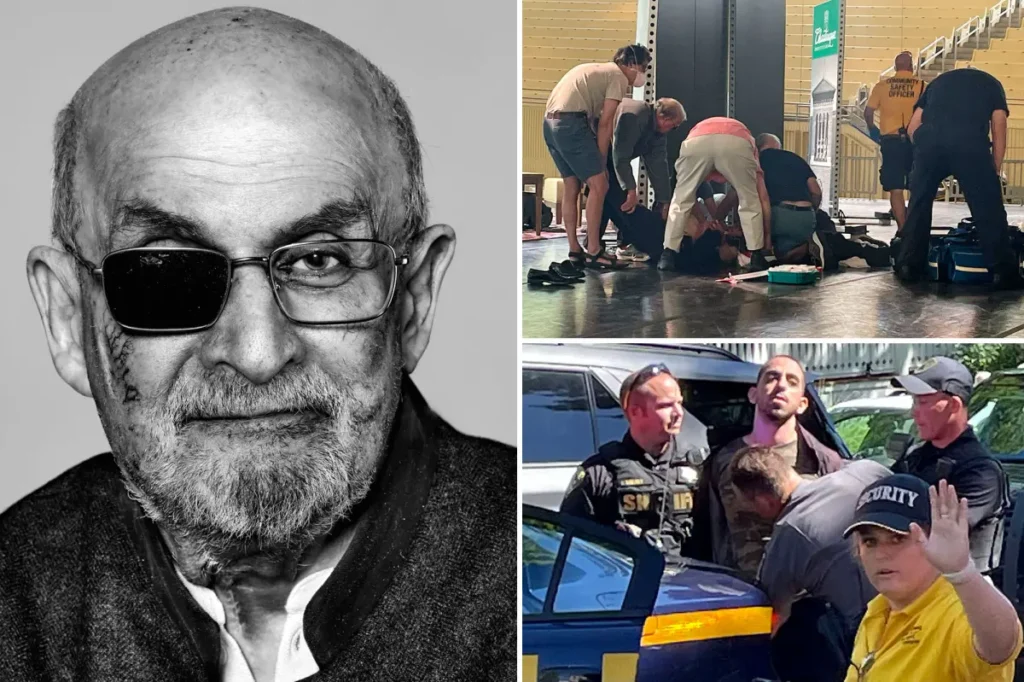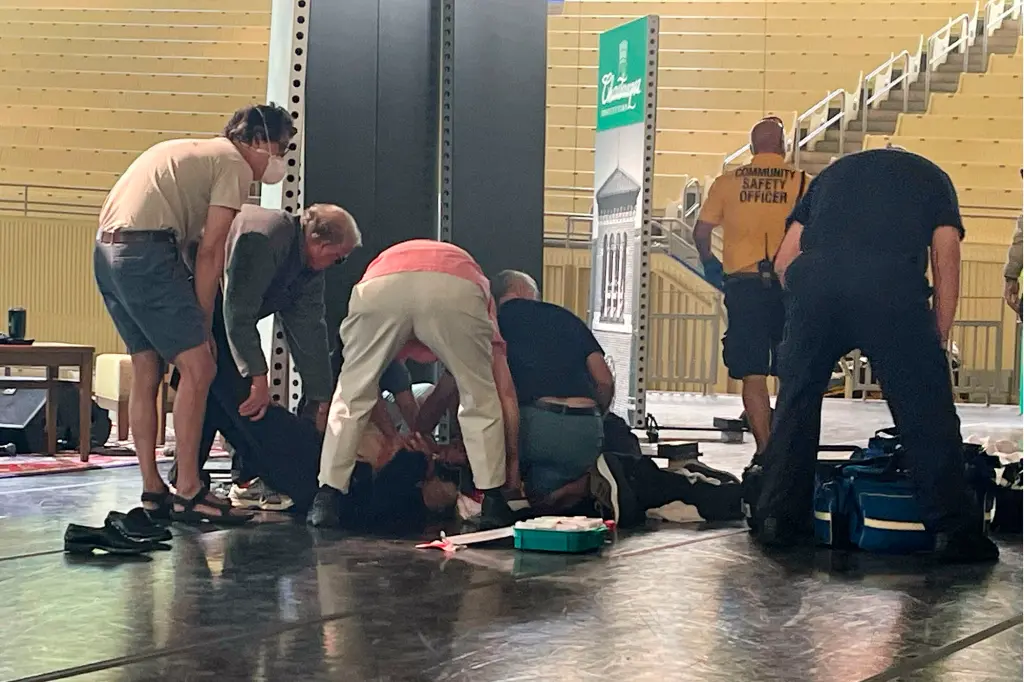The stabbing of Salman Rushdie at the Chautauqua Institution in New York on August 12, 2022, seemed like a prank. The horrifying reality became clear as the 75-year-old author lay bleeding after multiple stab wounds to his neck, stomach, chest, and right eye. I saw Henry Reese, another 75-year-old speaker, try to stop the 27-year-old attacker Hadi Matar and got injured in the process. Rushdie fought for his life through 17 days of hospitalization and spent over three weeks in rehabilitation. His injuries left permanent damage to his eye and hand.
Witness Recounts Shocking Moment of Salman Rushdie Stabbing
The peaceful Chautauqua Institution’s summer arts festival turned into a scene of horror in seconds. Rushdie had settled into his seat on stage to discuss how the United States serves as a haven for exiled writers.
How the peaceful literary event turned violent
The celebrated author sat in his chair as the panelist started the introduction. A masked figure in dark clothing suddenly rushed toward Rushdie from the stage’s right side. Rushdie noticed the attacker’s eyes right away – “dark and ferocious”. The attacker’s first blow landed on Rushdie’s right jaw and neck. He thought someone had punched him until he saw blood soaking through his clothes.
When Henry Reese realized it wasn’t a prank
Henry Reese sat nearby, ready for their planned discussion about City of Asylum Pittsburgh, and watched the terrifying scene. Reese thought this might be like in the Will Smith incident at the Oscars. Notwithstanding that, he quickly understood the truth as he watched the attacker’s arms move back and forth with grunting sounds. Reese jumped to help when he saw the blood. He tried to tackle the assailant though he had little room to move. The attacker struck Rushdie about 15 times and left wounds on his eye, cheek, neck, chest, torso, and thigh. The whole ordeal lasted only seconds but left both men hurt – Reese with a black eye and Rushdie fighting for his life.

Hero Describes Wrestling with Knife-Wielding Attacker
Henry Reese, the co-founder of City of Asylum Pittsburgh, jumped to protect Rushdie. His organization gives sanctuary to persecuted writers.
Why Reese jumped into action
His commitment to protecting exiled writers made him confront the attacker. “Our mission is to protect writers who are in sanctuary. And to see Salman Rushdie assaulted for his life is unimaginably difficult to describe,” Reese stated. He acted on his instincts to defend persecuted authors when he realized how serious the situation was.
How bystanders joined the struggle
Dozens of heroic audience members rushed to help as the attack happened. The core team members and attendees tackled the suspect and pinned him to the ground. A doctor among the audience gave immediate medical care to Rushdie before emergency services arrived. Rushdie later acknowledged that these quick actions saved his life.

What injuries the defender sustained
Reese suffered most important injuries during the violent encounter:
- A gash above his eye needed several stitches
- Deep bruising appeared around his right eye
- His vision became impaired temporarily for several weeks
The recovery process proved challenging for Reese. He slept in a chair for a week because of his injuries. Reading became comfortable again after about six weeks. “I’m doing well, everything is proceeding,” Reese told the BBC later, and moved attention away from his own injuries to show concern for Rushdie’s recovery.
Security Team Reveals Critical Response Timeline
Law enforcement officers at the Chautauqua Institution worked with event organizers to coordinate security measures before Rushdie’s appearance. A state trooper and county sheriff’s deputy managed to keep their positions on stage as part of standard security protocols.
When guards noticed the threat
The security team’s watchfulness is a vital part as the assailant, who had gotten a pass to enter the 750-acre grounds, came toward the stage. The state trooper near Rushdie spotted the threat as the attacker rushed forward. Both officers tried to stop him, but the attack happened so fast they had only seconds to react.
How emergency protocols were activated
The security team took several actions right after the attack started:
- The state trooper caught the suspect quickly
- Officers guided about 2,500 spectators away from the outdoor amphitheater
- A doctor from the audience stepped in to help as emergency medical protocols kicked in
New York’s governor, Kathy Hochul, praised the state trooper’s quick action that protected both Rushdie and the moderator. The Chautauqua Institution added new security measures after this whole ordeal:
- Metal detectors now stand at the amphitheater entrance
- People must show photo ID to buy gate passes
- No one can bring bags into the amphitheater
Michael Hill, the institution’s president, pointed out that such violence had never happened in their 150-year history. The officials now face a challenge to balance safety while keeping the institution’s welcoming atmosphere as they work on long-term security protocols.
Medical Team Explains Race Against Time
Blood soaked through Rushdie’s clothes while Dr. Martin Haskell, a physician from the audience, rushed to help. The author found himself lying in what he called “a lake of his own blood,” knowing his life was at stake.
Why first responders feared the worst
First responders faced a critical situation when they arrived. Rushdie had about ten stab wounds that included:
- Three critical wounds to his neck
- Four wounds to his stomach
- Multiple puncture wounds to his chest
- A severe cut on his right thigh
- Devastating damage to his right eye
The injuries were so severe that doctors worried about damage to his organs. The medical team found serious trauma to his liver and discovered severed nerves in his arm.
How quick action saved Rushdie’s life
The paramedics got a full picture and quickly airlifted Rushdie to UPMC Hamot, a specialized trauma center in Erie, Pennsylvania, 40 miles from where the attack happened. Surgeons worked for eight hours straight to save his life.
His wife, Eliza Griffiths, saw a frightening sight after the surgery. “He was a different color. He was cold,” she remembered, describing his face held together by staples. A surgeon later shared a significant detail about Rushdie’s survival: “The lucky part is that the man who attacked you had no idea how to kill a man with a knife”.
Rushdie spent 18 days in intensive care and three more weeks in rehabilitation before he started his recovery. He thinks he’s now at 75-80% recovered, though some changes are permanent – he can’t see from one eye and his physical strength isn’t what it used to be.
Conclusion
The violent attack on Salman Rushdie reminds us how writers risk their lives to express their thoughts. His survival demonstrates remarkable human resilience, despite suffering permanent scars that left him blind in one eye and physically weaker. The terrifying scene at Chautauqua Institution saw Henry Reese take immediate action, and the medical team’s expertise proved significant in those critical moments.
Quick thinking by the security team prevented further tragedy. The institution strengthened its safety protocols, showing their steadfast dedication to protect future speakers. The whole ordeal reinforced City of Asylum Pittsburgh’s mission to shelter writers who face persecution.
The shocking attack united heroes from every background. A fellow writer, medical staff, security guards, and numerous audience members stepped forward in this crisis. Their bravery ensured that literature’s voice stayed strong, even when threatened with silence.










Discussion about this post